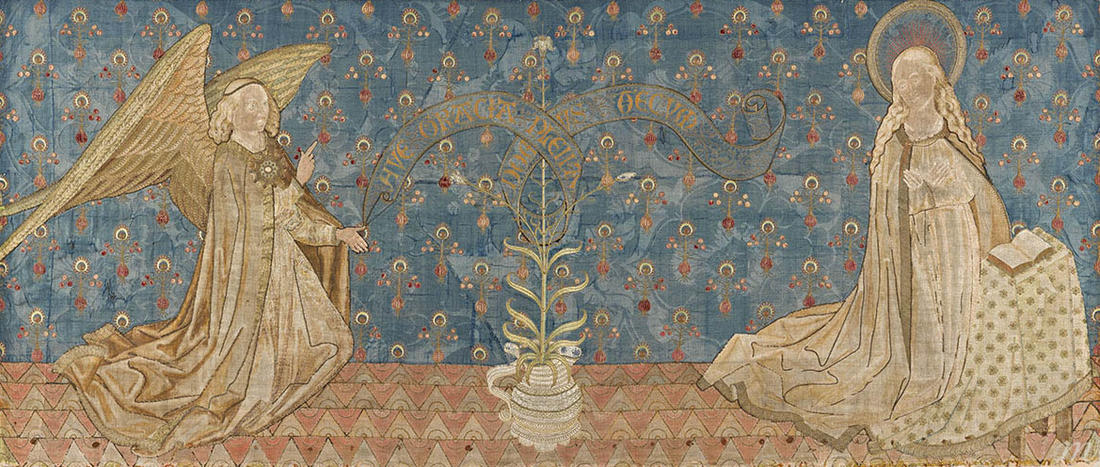The Lille antependium is a liturgical ornament, very common in the Middle Ages, which was placed in front of the church altar. It depicts the scene of the Annunciation, when the angel Gabriel announces to Mary that she’s expecting a child.
The decorations are made of wool, linen, hemp and silver thread embroidery sewn onto a linen canvas. These elements are in turn attached to a silk damask composed of nine pieces and dating from the early 16th century, when the object was restored. The fibres and colours are heavily worn: prolonged exposure of the work to light and its vertical presentation have weakened it over the centuries.
Everything indicates that the artist(s) involved in designing this piece were inspired by contemporary paintings. The detail of the angel's hair and wings, the remains of the underlying design... It seems they were inspired by a model developed in 1406 by the great painter Robert Campin for the church of Saint-Brice in Tournai, the town where he spent most of his career. This seems logical since the church of Noyelles-les-Seclin (Nord), where the antependium was originally found, was dependent on the diocese of Tournai !
Inv. A 25
Detail 1:
In part of the work, only the design, traced on the silk cloth before the embroidery work, is visible because the embroidery is worn. The pink tint of the faces was initially hidden under woollen threads of a stronger colour.
Detail 2:
The buckle or clasp used to hold the angel's cloak together is well preserved, as it’s made of silver thread, which is stronger. It demonstrates the meticulous embroidery work that can be seen in the highly detailed underlying design.
For information: for conservation reasons, this work has been replaced in the room by another tapestry antependium representing the Lamentation of Christ, made around 1530.

The Lille antependium is a liturgical ornament, very common in the Middle Ages, which was placed in front of the church altar. It depicts the scene of the Annunciation, when the angel Gabriel announces to Mary that she’s expecting a child.
The decorations are made of wool, linen, hemp and silver thread embroidery sewn onto a linen canvas. These elements are in turn attached to a silk damask composed of nine pieces and dating from the early 16th century, when the object was restored. The fibres and colours are heavily worn: prolonged exposure of the work to light and its vertical presentation have weakened it over the centuries.
Everything indicates that the artist(s) involved in designing this piece were inspired by contemporary paintings. The detail of the angel's hair and wings, the remains of the underlying design... It seems they were inspired by a model developed in 1406 by the great painter Robert Campin for the church of Saint-Brice in Tournai, the town where he spent most of his career. This seems logical since the church of Noyelles-les-Seclin (Nord), where the antependium was originally found, was dependent on the diocese of Tournai !
Inv. A 25
Detail 1:
In part of the work, only the design, traced on the silk cloth before the embroidery work, is visible because the embroidery is worn. The pink tint of the faces was initially hidden under woollen threads of a stronger colour.
Detail 2:
The buckle or clasp used to hold the angel's cloak together is well preserved, as it’s made of silver thread, which is stronger. It demonstrates the meticulous embroidery work that can be seen in the highly detailed underlying design.
For information: for conservation reasons, this work has been replaced in the room by another tapestry antependium representing the Lamentation of Christ, made around 1530.